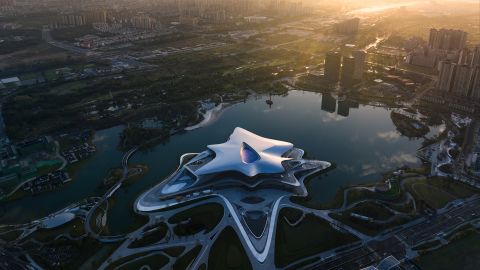The seven-point metallic star floats on the shiny surface of the lake, suggestive of a distant progress, or a spaceship landing on an outsider planet. It appears as though something straight out of sci-fi. Which it is, as it were: it’s the fresh out of the box new Chengdu Sci-fi Gallery in the capital of Sichuan area in Southwest China.
From one side, the powerful rooftop imitates the slanting mountains somewhere far off; from another, the shade assumes the presence of a cloud, its cantilever curves suspended above consistent sheets of glass.
“From each point, it will continuously appear to be unique; it will constantly look surprising or unforeseen,” said Paulo Flores, one of the task chiefs at Zaha Hadid Planners, which planned the historical center.
Maybe more unforeseen than the actual plan is the time it took to fabricate.
The gallery was charged in 2022 to have the current year’s 81st yearly World Sci-fi Show, nicknamed Worldcon. A structure of this size and intricacy would regularly require four to five years to construct, says Flores. In any case, the 59,000 square-meter building — which is multiple times the size of the Sydney Show House — went from idea to the end in only a year.
Be that as it may, in spite of the tight circle back for Flores and his group, it was the fantasy task. ” Sci-fi has forever been a vital wellspring of motivation for our plans,” said Flores. ” Sci-fi has consistently taken that jump forward, taking a gander at what innovation is right now and what innovation could develop into.
“We need to be important for that development of making what’s to come resembles — outwardly, yet in addition mechanically.”
Digital designs
The London-based design firm is no more abnormal to innovation. The company’s namesake, Zaha Hadid, was a trailblazer in computerized plan, and the devices she utilized empowered her to make dynamic, modern structures.
“We can make these sorts of calculations utilizing polygonal displaying programming,” made sense of Flores, which makes a “three-layered reenactment of the structure.”
With this undertaking, the innovation was vital to making an aggressive plan, yet additionally executing it quickly. Only fourteen days after the firm won the opposition, development on the task started.
Utilizing an assortment of plan programming, including computerized displaying examination, the group had the option to speed up the course of events, and guarantee that everybody, from modelers to materials producers to development laborers, was in total agreement.
Satoshi Ohashi, another of the task chiefs, said that development and configuration occurring in equal “could never have been managed without these new apparatuses.”
Ohashi added that the computerized displaying examination permitted the group to improve the structure’s construction for Chengdu’s environment. By breaking down climate and ecological boundaries, the product informed choices about the size and point of the rooftop shade to shield insides from direct daylight.
Green tech is coordinated to limit the structure’s working effect, as well, with sunlight based chargers inserted into the extensive rooftop to assist with fueling the structure, and bay windows and floor-to-roof windows to lessen the requirement for fake light during the day.
The group likewise needed to source materials locally to save opportunity and arrive up with basic approaches to making their idea a reality. For instance, they made a measured aluminum board framework that sits “under the skin” of the rooftop covering, which makes “smooth and consistent” bends while likewise hurrying up to create in a production line, said Ohashi.
City of the future
Currently home to in excess of 20 million occupants — and developing — Chengdu has quickly extended over the most recent couple of many years.
Recently, the city bested China’s new first-level urban areas list, which positions cities in light of elements like occupant way of life, business open doors, and transport.
The Sci-fi Gallery is important for a bigger “Future City” improvement in the Pidu region, beyond the city. Known as Chengdu Future Science and Innovation City, the 4.6-square-kilometer (1.8-square-mile) site will house various new colleges, research facilities and workplaces.
“Some portion of that development is additionally this consideration regarding the future, science and innovation, incorporating that into the city, and developing that economy,” Ohashi made sense of.
The country’s extravagant “sci-fi industry” incorporates distributing and film discharges, with Chengdu at the middle. Chengdu is additionally the origination of Sci-fi World, one of the world’s most-perused science fiction magazines, which was established in the city in 1979.
The exhibition hall opened on time to have its debut occasion — whenever Worldcon first has been facilitated in China, and just the second time in Asia. Dave McCarty, bad habit seat of Chengdu Worldcon and a coordinator with the occasion for a very long time, portrayed the exhibition hall as “the best office by a wide margin that the Worldcon has at any point been facilitated in,” and said having a reason constructed area caused the occasion to feel more unique contrasted with facilitating it in “cutout” assembly halls.
“Having that committed space makes a brilliant home for sci-fi,” McCarty added.
With its fruitful offered to have the 81st Worldcon, Ohashi trusts that the new gallery and occasion space can turn into “a notable milestone that will address their sci-fi industry” and will sustain the desires of the blossoming “Future City.”
“They can now say that they are China’s sci-fi capital,” he said.

